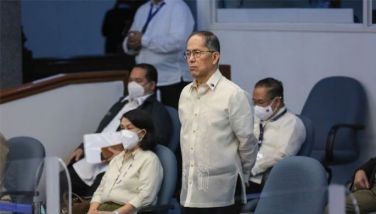Asean adopts Cebu resolution on environment as summit ends
November 12, 2006 | 12:00am
MACTAN ISLAND, Cebu — Environment ministers of the Association of Southeast Asian Nations (ASEAN) resolved yesterday to further enhance regional cooperation and strengthen efforts in enforcing environmental laws.
Ending its three-day Environment Summit here, the environment ministers from the 10 member-countries of ASEAN adopted a decree called the "Cebu Resolution on Sustainable Development," which emphasizes the need to address environmental issues by all parties.
"The ministers reviewed regional cooperation on a number of environmental activities... and resolved to work towards an environmentally sustainable ASEAN community," stated the Joint Press Statement of the ASEAN, read by Environment Secretary Angelo Reyes.
Among the topics discussed by the ministers were the pressing problems on trans-boundary haze pollution and biodiversity conservation.
ASEAN expressed serious concern over the recurring trans-boundary haze blanketing Singapore and parts of Indonesia and Malaysia, which was caused by the forest fire in Indonesia, specifically in Sumatra and Kalimantan.
This problem was aggravated by the extended dry weather condition during El Niño years.
For this, ASEAN resolved to improve prevention, monitoring, and mitigation of land and forest fires and continue assisting affected member countries within the framework of the ASEAN Agreement on Trans-boundary Haze Pollution.
The ASEAN ministers also agreed to establish the Sub-regional Ministerial Steering Committee (MSC), consisting of environment ministers from the five most-affected countries — Brunei Darussalam, Indonesia, Malaysia, Singapore, and Thailand. The MSC would oversee the implementation of concrete actions to address land and forest fires that cause trans-boundary haze pollution.
Member countries likewise agreed to establish the Haze Fund as part of regional efforts to tackle this recurring problem.
Indonesia and Singapore have committed to give $50,000 each to the fund.
Reyes, however, said that the ministers have not placed a target amount for the Haze Fund but pledges or commitments to jumpstart the fund are welcome.
ASEAN deputy secretary general Dr. Soeung Ratchavy said commitments to the Haze Fund should have the consent of the heads of states.
On Oct. 25, Singapore raised before a UN committee on sustainable development its concern over the haze pollution in Southeast Asia.
Singapore, through its charge d’affaires in New York, pointed out before the UN the environmental, health, and economic damage brought about by the annual haze problem in the region.
Indonesia’s action plan to address the problem has been endorsed by the ASEAN but a technical working group would still work on the details, including its terms of reference.
During the Environment Summit, ASEAN also launched its 3rd State of the Environment Report 2006, which recognizes the "enormous challenge" the region is facing towards achieving an environmentally sustainable ASEAN community.
One of these challenges is conserving the region’s biological and genetic resources, which include wildlife — plant and animal species — and microorganisms.
The ASEAN expressed its support and commitment to the effective operations of the recently established ASEAN Center for Biodiversity in the Philippines to promote biodiversity conservation in the region.
International marine scientists regard the Philippines as the "center of marine biodiversity in the world" because of its great species of marine and coastal resources.
International marine scientists further acknowledged the richness of the Verde Island Passage located between the province of Batangas and Mindoro, and declared the area as the "center of marine shorefish biodiversity."
Citing a study entitled "Human footprint too big for nature," Reyes said the Philippines has a biocapacity limit of 1.1 hectares per person, which means that at least 1.1 hectares of forest teeming with rich biodiversity are needed to produce useful biological materials to support every Filipino’s need for food or medicine.
Earlier, President Arroyo signed an executive order, which established guidelines for all government agencies in the Philippines to integrate the protection, conservation and sustainable use of biological diversity into their policies, plans and programs.
In Southeast Asia, the average biocapacity limit per person is 1.8 hectares. It is 1.4 hectares in Thailand, 1.1 hectares in Indonesia, 0.9 hectare in Myanmar, Laos and Vietnam and 0.7 hectare in Cambodia.
ASEAN biodiversity, Reyes stressed, is crucial to achieving a better quality of life in the region. — With Perseus Echeminada
Ending its three-day Environment Summit here, the environment ministers from the 10 member-countries of ASEAN adopted a decree called the "Cebu Resolution on Sustainable Development," which emphasizes the need to address environmental issues by all parties.
"The ministers reviewed regional cooperation on a number of environmental activities... and resolved to work towards an environmentally sustainable ASEAN community," stated the Joint Press Statement of the ASEAN, read by Environment Secretary Angelo Reyes.
Among the topics discussed by the ministers were the pressing problems on trans-boundary haze pollution and biodiversity conservation.
ASEAN expressed serious concern over the recurring trans-boundary haze blanketing Singapore and parts of Indonesia and Malaysia, which was caused by the forest fire in Indonesia, specifically in Sumatra and Kalimantan.
This problem was aggravated by the extended dry weather condition during El Niño years.
For this, ASEAN resolved to improve prevention, monitoring, and mitigation of land and forest fires and continue assisting affected member countries within the framework of the ASEAN Agreement on Trans-boundary Haze Pollution.
The ASEAN ministers also agreed to establish the Sub-regional Ministerial Steering Committee (MSC), consisting of environment ministers from the five most-affected countries — Brunei Darussalam, Indonesia, Malaysia, Singapore, and Thailand. The MSC would oversee the implementation of concrete actions to address land and forest fires that cause trans-boundary haze pollution.
Member countries likewise agreed to establish the Haze Fund as part of regional efforts to tackle this recurring problem.
Indonesia and Singapore have committed to give $50,000 each to the fund.
Reyes, however, said that the ministers have not placed a target amount for the Haze Fund but pledges or commitments to jumpstart the fund are welcome.
ASEAN deputy secretary general Dr. Soeung Ratchavy said commitments to the Haze Fund should have the consent of the heads of states.
On Oct. 25, Singapore raised before a UN committee on sustainable development its concern over the haze pollution in Southeast Asia.
Singapore, through its charge d’affaires in New York, pointed out before the UN the environmental, health, and economic damage brought about by the annual haze problem in the region.
Indonesia’s action plan to address the problem has been endorsed by the ASEAN but a technical working group would still work on the details, including its terms of reference.
One of these challenges is conserving the region’s biological and genetic resources, which include wildlife — plant and animal species — and microorganisms.
The ASEAN expressed its support and commitment to the effective operations of the recently established ASEAN Center for Biodiversity in the Philippines to promote biodiversity conservation in the region.
International marine scientists regard the Philippines as the "center of marine biodiversity in the world" because of its great species of marine and coastal resources.
International marine scientists further acknowledged the richness of the Verde Island Passage located between the province of Batangas and Mindoro, and declared the area as the "center of marine shorefish biodiversity."
Citing a study entitled "Human footprint too big for nature," Reyes said the Philippines has a biocapacity limit of 1.1 hectares per person, which means that at least 1.1 hectares of forest teeming with rich biodiversity are needed to produce useful biological materials to support every Filipino’s need for food or medicine.
Earlier, President Arroyo signed an executive order, which established guidelines for all government agencies in the Philippines to integrate the protection, conservation and sustainable use of biological diversity into their policies, plans and programs.
In Southeast Asia, the average biocapacity limit per person is 1.8 hectares. It is 1.4 hectares in Thailand, 1.1 hectares in Indonesia, 0.9 hectare in Myanmar, Laos and Vietnam and 0.7 hectare in Cambodia.
ASEAN biodiversity, Reyes stressed, is crucial to achieving a better quality of life in the region. — With Perseus Echeminada
BrandSpace Articles
<
>
- Latest
- Trending
Trending
Latest
Trending
Latest
Recommended































